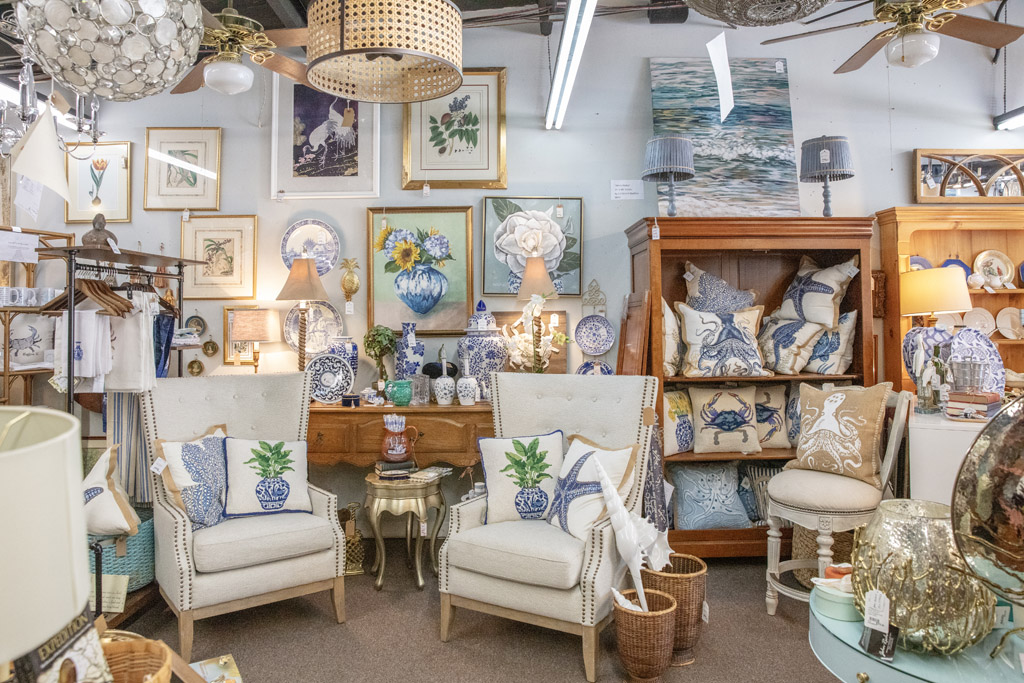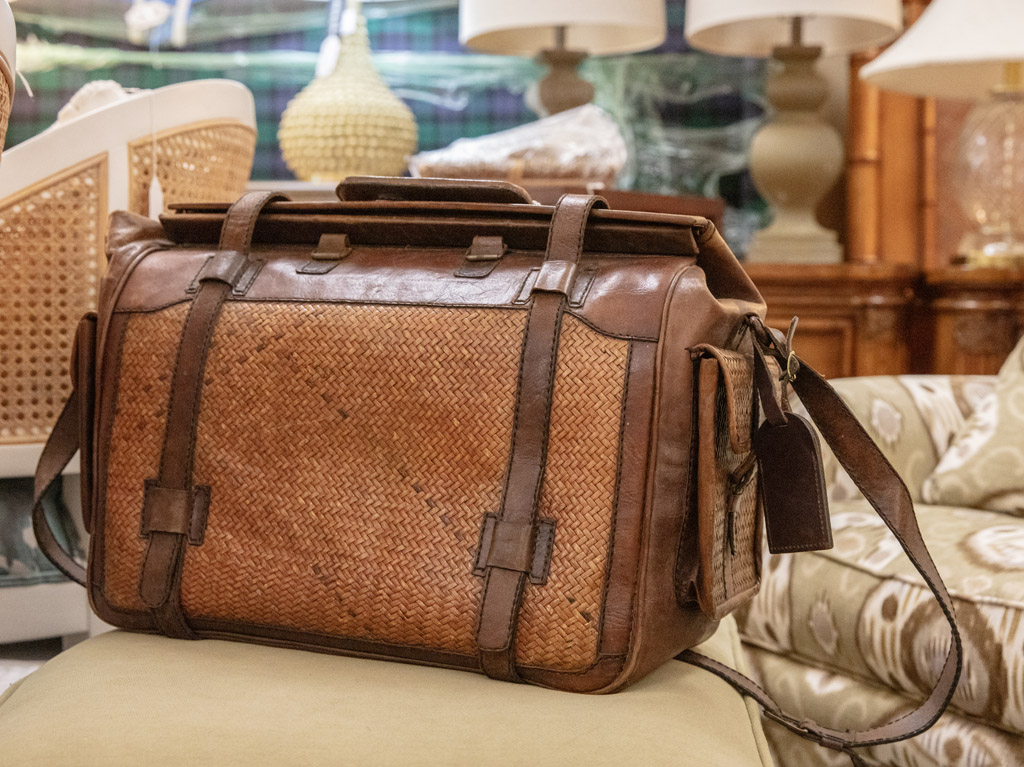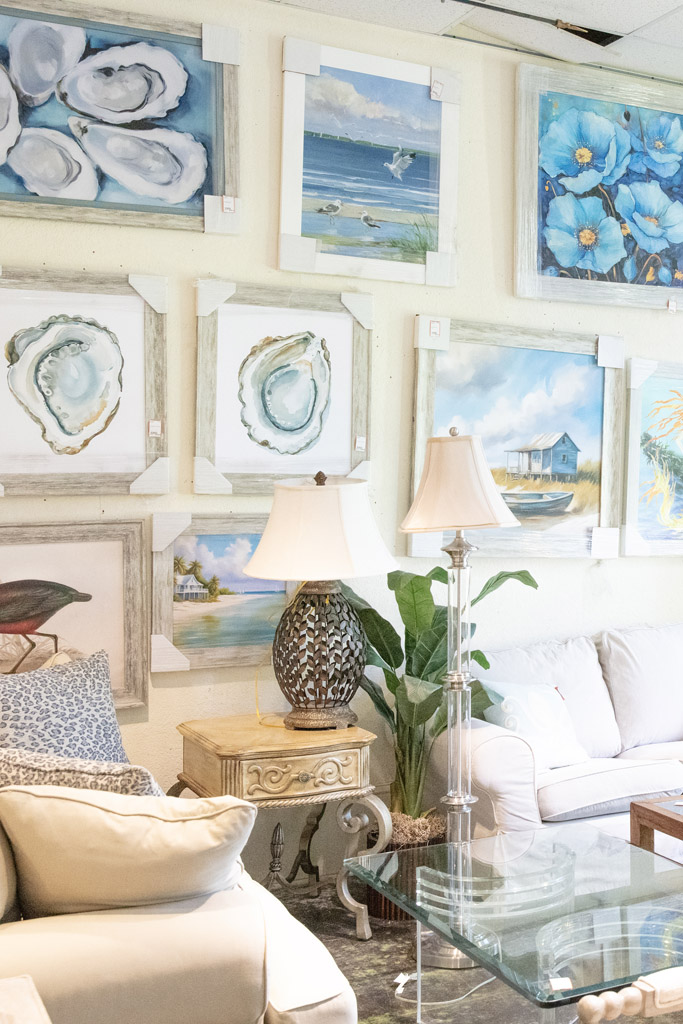Modeled by Taylor Kent . Styled by Kaila Jeffcoat
Americans have never bought so many new things. U.S. retailers churn out a record $5 trillion in goods each year, according to the National Retail Federation. At the same time, the surge in e-commerce is flooding the market with unsold inventory, returns, and secondhand items.
Whereas only about 8% of goods bought in a store are returned, more than 20% of items bought online are sent back. For clothing, that number can soar as high as 40%. That has left a mountain of stuff that needs to go somewhere. And that doesn’t even count the stuff that we need to purge from our own homes.
Is thrifting the answer?

Furniture and paintings are artfullly arranged at Coastal Exchange in Old Town Bluffton.
Some call their shopping experiences “treasure hunts” and can spend an entire day perusing through aisles and racks. Some know exactly what they are looking for. Others are searching for particular brands at particular prices that they know they can snag for a bargain and resell for a profit. Whatever their motivation, these folks, commonly called “thrifters,” are shopping in a way that is both financially savvy and socially responsible.
Thrift stores and consignment stores sell previously owned wares. The items are sold at significantly reduced prices compared to traditional retail stores, making thrift and consignment stores an affordable shopping option. Thrift stores sell donated items, while consignment stores sell items no longer needed by the folks who consign the items.

A vintage leather bag at Classic Consignments
Because the inventory is constantly changing and typically unique, many thrifters frequent their favorite stores several times a month – even weekly – to find all manner of merchandise, from antiques and collectibles to retro fashions and modern brands.
The economic benefits thrifting provides are enjoyed by both shoppers and communities. For shoppers, the low prices afford people a chance to save or make money by purchasing items they may not otherwise afford. Simultaneously, thrift stores create jobs, support charities, reduce waste, and stimulate local economies.
Possibly due to one or a combination of these benefits, recently there has been an upsurge in thrifting. Selling used items is big business. For example, one recent study estimates the resale industry in the U.S. to have annual revenues of approximately $13 billion.

Taylor Kent models an ensemble from Three Sisters Resale & More at Capital Coffee & Chillers
Donating and shopping at thrift stores significantly reduces waste and environmental impact. In the U.S., individuals throw out 60 to 80 pounds of textile waste each year – the EPA estimates that as more than 17 million tons. Donating gently used clothing, furniture, electronics, books, and other household items to thrift stores gives those items a second life and prevents them from clogging up landfills where it can take months and even years for these materials to fully break down.
In what began out of necessity as a teenager, Iva Lazovic, a Hilton Head local, has now made a career for herself shopping in secondhand stores from here to Savannah, then reselling her finds for a profit. Some of her favorite shops are The Litter Box and Goodwill on the island, Goodwill in Bluffton, and Savannah Goodwill Bins.

Artwork on display at Vintage Market in Bluffton.
Previously in the food and beverage industry, Lazovic eventually realized that she could make as much money by listing four or five articles of clothing a week on Poshmark as she could make in seven or eight hours in the restaurant.
“At the beginning, Poshmark was just traditional sales,” Lazovic said. “I would take pictures and list items and just hope that they sell by sharing them to random users and creating connections through the platform. Then, Poshmark created a feature where sellers can livestream, and it changed everything for me. People bid on specific items in my ‘closet’ in real time. I now livestream my items three times a week and make as much money as I ever made in the service industry.”

Taylor’s ensemble styled from Goodwill by Kaila Jeffcoat.
In fact, due to her remarkable success, Poshmark invited Lazovic to New York City to feature her on their platform. She shared with their global audience what she does to generate success. Primarily, Lazovic said, she is successful because she is her authentic self online. Additionally, she has some tips and tricks, one of which is finding BOLO brands. “BOLO” is an acronym for “be on the look out” and is a term used in reselling to refer to products that are in high demand and can be sold for a profit. BOLOs are often shared in Facebook groups or other online communities and can help sellers find profitable products to sell. Some of Lazovic’s BOLO brands are St. John, Lululemon, Diane Von Furstenberg, Free People, Lilly Pulitzer, Revolve, Z Supply, Miss Me, and Johnny Was.

Paintings sit waiting for wall space at Classic Consignments on Arrow Road.
Lazovic also recommends using Google Lens when thrifting to find comps (comparable previous sales) and make sure that you aren’t paying so much that you won’t profit. (There are fees for using the Poshmark app.)
“Don’t just pick up anything you see,” she advises. “Even if it’s a high-end brand, it may not sell. Take a screenshot of the item, search on Google Lens, and see what it’s listing for elsewhere. Also, be fully transparent about any flaws. While people will buy things that have flaws, be honest because you do not want a case opened up against you on any selling platform.”
Finally, Lazovic advises having a system of organization, such as putting items in poly mailers or plastic bags for easy shipping. This will help you to move things efficiently and avoid sitting on inventory.
“You want to move stuff before you buy more, so you don’t become a hoarder,” Lazovic said. “Never go sourcing when you’re sitting on what we call a ‘death pile.’”

Ensemble from The Litter Box. Vintage suitcases found by editor whilst thrifting in Palm Harbor, FL.
While Lazovic never throws clothes away, she doesn’t hoard. When she has a pile of items that haven’t sold, she donates them back into the recycling chain, confessing that though she enjoys the money she makes and the fun she has thrifting, she gets a lot of satisfaction from knowing that she is helping to reduce waste on the planet.
On the island, Lazovic shops and donates to The Litter Box, which benefits the Hilton Head Humane Association.
“The Litter Box thrift store originated to support the island’s feral cat program, which is a free Trap-Neuter-Return (TNR) program for the community of Hilton Head and all of Beaufort County,” said Franny Gerthoffer, board member and executive director of the animal rescue and shelter.
The Litter Box began 24 years ago in a garage with the mission to raise money to neuter feral cats. Because they didn’t have any money for rent, the group went around to empty storefronts and set up until the storefronts were leased.
“Our plan was to bring activity and interest to the landlord’s storefront if they let us set up there,” Gerthoffer said. “Finally, we raised enough money to pay rent.”
Now, The Litter Box has a permanent home on Old Wild Horse Road, and now the money they raise helps not just feral cats, but all stray animals on Hilton Head.
Gerthoffer reports that typically when people donate to the thrift store, they then buy somebody else’s stuff, so the recycling wheel keeps rolling. The Litter Box also recycles with a textile company, so the linens and clothes that they don’t sell are recycled and kept out of the landfill. In return, The Litter Box (and our island animals) get pennies on the dollar for the pounds of clothing that they donate.
The Litter Box offers knick knacks, dishware, appliances, clothes, higher end boutique items, and lots of furniture. There is a home improvement section with equipment like hammers, screw guns, nails, clips, and the like. They also have a garden area and an impressive selection of books.
“We actually have different book companies come in, go through our books, and buy them because they know we have some real treasures,” Gerthoffer said. “A book that we might sell for $1 can resell for $50 through the right platform.”
For rental properties that are turning their furniture over, The Litter Box is a good place to bring furniture or for rental property owners to outfit their homes inexpensively but with a great aesthetic. There are dining sets, chairs, armoires, custom bathroom and kitchen sinks and counters, lots of living room furniture.
“And for people who are redoing an area in their home, like their kitchen, instead of just letting the reno company tear it out and haul it away, we have a big truck and drivers who will pick up your furniture and appliance donations and bring them to the store for resale,” Gerthoffer said.
The Litter Box posts their treasures on Facebook, their website, and their eBay store, where they offer a lot of high-end items and collectibles. Other than their one full-time manager and two part-time employees, The Litter Box is run by volunteers, which means aside from the cost of personnel, rent and utilities, all the profit goes to the animals.
Another island treasure trove for thrifters is Three Sisters Resale & More, a consignment shop owned by – surprise! – three sisters, Carol Monahan, Janet Adams, and Kathie Tofaute. The owners are celebrating their 10th year in business.
When you inquire as to the roots of their passion for re-purposing, reclaiming, upcycling, and collecting vintage items and antiques, they credit their parents.
“The anticipation of the hunt, the excitement when special items are found, and the continued enjoyment of those treasures is in our blood,” Monahan said. “In our store we sell a little bit of everything. We have repurposed, reclaimed, upcycled, vintage, and new items, which includes clothing, books, small furniture, sports memorabilia, artwork, kitchen items, china, crystal, and more. Currently, we even have two vintage marionettes in the store.”
As a consignment shop, they take things in, and the consigners sign a contract for a year, which is the normal cycle for tourists. After a year, if the item hasn’t sold, the consigner can either pick it up or they become property of the store, where the sisters will either donate the item or take it into inventory. Once an item is sold, the consigner receives 40%, and the store keeps 60% of the selling price. While the store is a for-profit business, they do donate a portion of every sale to one of four charities.
“Currently we are promoting MUSC Hollings Cancer Center, Hopeful Horizons, Daufuskie Island Turtle Team, and the Ukraine,” Monahan said. Each customer gets to select the charity of their choice to receive proceeds from a percentage of their sale.
Three Sisters customers include both locals and tourists from all over the world – even consigners from as far away as Holland.
Making donations to thrift stores fuels artists and creatives who upcycle furniture and recreate clothing. One of Lazovic’s favorite people to donate her unsold items to is Susan Rafetto of Peace by Piece. Rafetto repurposes thrift store clothing by upcycling it into brand new, one-of-a-kind (and even custom) pieces by hand. The mission of her business is to rescue pieces that still have “good bones” from the landfills, ultimately bringing more peace to the planet. As well, her passion is to make people feel good in their clothes.
Rafetto’s mom and grandmom made all of her and her twin sister’s clothes when they were growing up, so she developed an appreciation and proclivity for sewing. When she was moving to Hilton Head, she was hoping to purge some clothes from her closet and began throwing things on the bed. In a moment, she thought, “I don’t really wear these anymore, but I really like the fabric of this piece and the collar and sleeves of this piece. … I wonder if I could upcycle them into a brand-new top?” She loved the result, and her business was born.
Since then, Rafetto scours local thrift stores for unique pieces that stand out, either from fabric or design, then she marries her finds to create amazing, upcycled fashion that others feel great about buying and wearing. She also collaborates with people like Lazovic and those who have sentimental items they don’t want to get rid or don’t know what to do with.
“I just created a beautiful piece for a woman who lost her parents and siblings in an accident a few years ago,” Rafetto said. “She had a robe and a hoodie and a couple of other items from her family. She gave them to me with full creative license, and I was able to transform them into something beautiful that not only she absolutely loves, but that she can wear whenever she wants.”
Shopping at thrift stores provides essential financial support for charities and nonprofit organizations. A large percentage of revenues from thrift stores goes directly to funding charitable causes and local community programs.
For example, Goodwill Industries International and The Salvation Army operate thousands of thrift stores worldwide, using the proceeds to provide job training, education, and other social services to people in need. When you buy products at Goodwill or Salvation Army stores, your shopping dollars directly enable these organizations to carry out their charitable missions.
Other thrift stores may support medical research, local churches, the arts, or various other causes. Shopping at a thrift store allows customers to donate to a good cause just by purchasing the items. The charitable donations generated each year from thrift store sales are enormous, providing critical funding that keeps many worthy programs running.
Thrift stores provide employment opportunities for local citizens, including those from marginalized groups who might have difficulty finding work elsewhere. Working at a thrift store offers an inclusive, supportive environment for employees to gain job skills and experience. They can sort donations, arrange displays, work the cash register, and clean. The jobs also provide a steady income, a sense of purpose, and, many times, health insurance and retirement that may otherwise be unattainable.
Thrift shops also create secondary jobs and economic ripple effects. Thrift stores contract with local companies for services like trucking to pick up donations, maintenance, construction, and more. Thrift store employees also go back into the community through spending at other local businesses. In this way, even a single thrift store can create numerous jobs and touch many lives through employment and economic opportunity.
Some industry experts predict that in the not-too-distant future, we will be able to walk into a any local small business and even some big box stores and see a comparable display of new and used stuff, sparking the question, “Why buy anything new?” It’s so easy now, especially with the incredible surplus of really cool and barely used goods coming into the pipeline, just to crank up the volume on used goods and lower the volume on new.
The point is that ownership can be a less permanent fixation. It’s entirely possible – and even preferable for many – to have fewer, better things in our lives. Once they’re no longer needed, we let them go to the next owner. Consumption becomes completely circular, and shopping secondhand not only makes sense, but “cents.”


